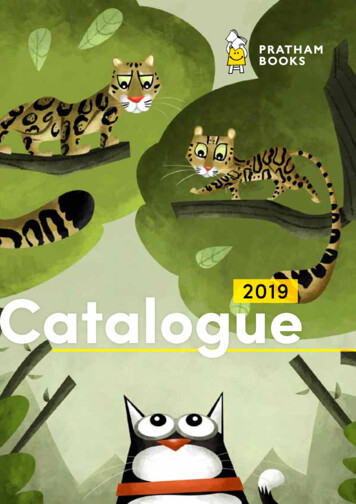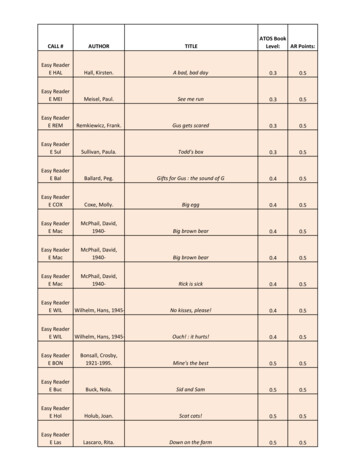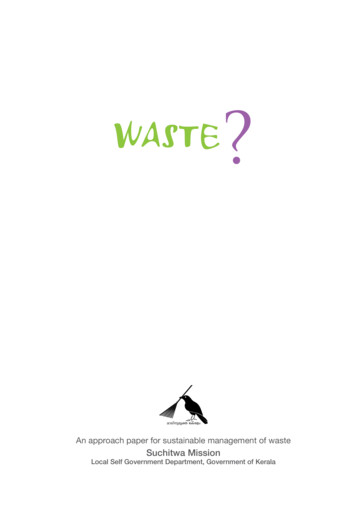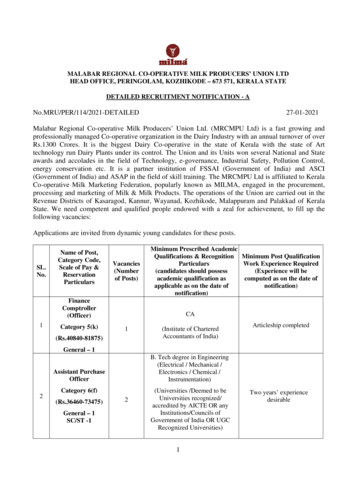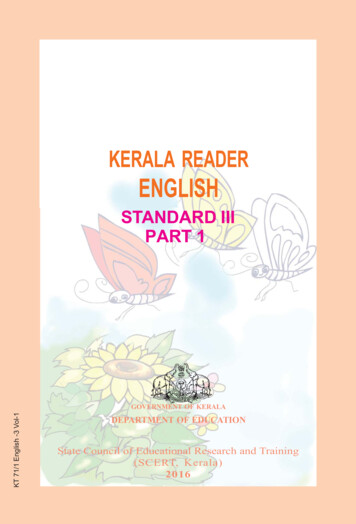
Transcription
KERALA READERENGLISHSTANDARD IIIPART 1KT 71/1 English -3 Vol-1GOVERNMENT OF KERALADEPARTMENT OF EDUCATIONState Council of Educational Research and Training(SCERT, Kerala)2016
PLEDGEIndia is my country. All Indiansare my brothers and sisters. I lovemy country, and I am proud ofits rich and varied heritage. I shallalways strive to be worthy of it.I shall give my parents, teachersand all elders respect, and treateveryone with courtesy.To my country and my people, Ipledge my devotion. In theirwell-being and prosperity alonelies my happiness.THE NATIONAL ANTHEMJana-gana-mana-adhinayaka, jaya ngaUchchala-Jaladhi-taranga.Tava shubha name jage,Tava shubha asisa mage,Gahe tava jaya gatha,Jana-gana-mangala-dayaka jaya heBharata-bhagya-vidhata.Jaya he, jaya he, jaya he,Jaya jaya jaya, jaya he!Kerala Reader - EnglishStandard III Part 1Prepared by:State Council of Educational Research & Training (SCERT)Poojappura, Thiruvananthapuram -12, Kerala.E-mail: scertkerala@gmail.comTypesetting by: SCERT Computer Lab.First Edition : 2014, Reprint : 2016Printed at: KBPS, Kakkanad, Kochi - 30 Government of KeralaDepartment of Education2015
Dear childrenThe English Textbook Part 1 for Standard III isa good collection of stories, poems, picturesand activities. There are stories of butterflies,animals, birds and a little boy with a magicring. Your teacher will take you to theirwonderful world of adventure. I hope you willlike the stories, poems and pictures in this book.There are also interesting and challengingactivities along with each unit of the textbook.Enjoy doing the activities on your own. You canapproach your teacher whenever you need help.I am sure you will love reading this book.Wish you all the best.Dr. P.A FathimaDirectorSCERT
Textbook Development TeamMembersBindu S S Trainer, BRC Balaramapuram, ThiruvananthapuramDileep Kumar K Vijaya AUPS, Thuyyam, MalappuramJose D Sujeev GHSS Karakulam, ThiruvananthapuramMohammed Siddique Programme Officer, SSA, ThrissurMohammed Athaulla ALPS Udinur South Islamia, KasaragodeNisha P Lecturer, DIET, MalappuramNisha T N K Nellacherri LPS, Onchiyam, VadakaraReshmi Reghunath GHSS Karakulam, ThiruvananthapuramSajith E P GVHSS Payyoli, KozhikodeSamsudheen A G GLPS Beericheri, Thrikarippur, KasaragodeSithara M LPSA GLPS Kallara, KottayamSreelatha S Tutor, District Centre for English, Neyyattinkara, ThiruvananthapuramSujith S Pantheerankavu HS, KozhikodeExpertsDr Jayaraj P K Director, State Institute of English, ThrissurDr Muraleedharan K C Associate Professor, Payyannur College, KannurDr Sushil Kumar R Associate Professor of English, DB College, SasthamcottaDr Sherrif K M Reader, Dept. of English, University of CalicutArtistsHaridasan N K Art Teacher, GHSS Azhiyoor, KozhikodeRamesan P Art Teacher, Iringannur HSS, KozhikodeSudheer P YAcademic Co-ordinatorDinesh K T Research Officer, SCERT, Kerala
CONTENTSUnit 1Billu, the Dog7Unit 2Three Butterflies33Unit 3Mowgli50Unit 4The Magic Ring70
Unit 1Billu, the DogA farmer had a faithful dog called Billu.He was very old and had lost almost all his teeth.What do you see in the picture?Do the animals in the picture help us in any way?How do they help us?Can Billu help the farmer? Why?7
Billu, the DogOne day the farmer told his wife:I’ll throw Billu outtomorrow. He is of nouse to us.Please don’t. Let the poorcreature live here. He hasserved us since he was apup.But he is too old to do anythingnow. The thieves aren’t scared ofhim at all. Tomorrow shall be hislast day with us!If you were the farmer, would you throw Billu out? Why?What will Billu do now?8
Billu, the DogBillu heard what the farmer said. He wasfrightened. In the evening, he went to the woods.He met his best friend, the fox. He told the foxwhat was going to happen.Don't worry.I’ve got an idea.If Billu approached you, what advice would you give him?9
Billu, the DogThe fox shared the idea with Billu.What would be the fox’s idea?10
Billu, the DogNext day, early in the morning, the farmer wentto the field with his wife. They took their babywith them. They laid the baby in the shade of atree. While they worked, the old dog stood nearthe baby watching it.Other than guarding homes, how do dogs help their masters?Have you heard of such stories? Share them with your friends.11
Billu, the DogSuddenly, the fox came out of the bush. It rantowards the baby. It jumped at the baby.!d.oyGm,OhHelp, help!Save my childBow.wow.What will happen to the baby?12
Billu, the DogBillu attacked the fox and saved the baby.Did you ever think that this was the fox’s idea?13
Billu, the DogBillu is our dear dog!I was stupid to think ofthrowing him out.Thank God! Billusaved our child.What changed the farmer’s attitude towards Billu?14
Billu, the DogDear, let’s go home andgive our Billu a gooddinner.The farmer patted Billu affectionately.The mother was very happy to get her baby back.Did Billu wish that this would happen?Was the fox’s idea effective?15
Billu, the DogThe whole family lived together happily.16
Billu, the DogLook at the pictures given below. Sequence them and narrate the restof the story.KT 71/2 English -3 Vol-1You may begin like this:The farmer was happy. He built a kennel for Billu. .17
PoemNow, read the poem about animals and find out what theycan do.Little Pup, Little PupLittle pup, little pup,What do you say?‘Woof, woof, woof!Let’s go and play.’Kitty cat, kitty cat,How about you?‘Meow, meow, meow!And I purr, too.’Pretty bird, pretty bird,Have you a song?‘Tweet, tweet, tweet!The whole day long.’Who is the speaker of the poem?Who answers the questions of the speaker?18
PoemJersey cow, jersey cow,What do you do?‘Moo, moo, moo!And give milk too.’Little lamb, little lamb,What do you say?‘Baa, baa, baa!Let’s all play.’What do the animals and bird say? Complete the table given below.One is done for you.Animal/Birdlittle pupSound it makeswoof, woof, woofWhat it can doplay19
Activity 1The fox’s idea saved Billu. Billu was very happy. He ran to the forestand met the fox.Continue the conversation.Billu :Oh! My dear friend .Fox :.Billu :.Fox :.Activity 2Billu served his master from the time he was a pup. The young one ofa dog is called a pup or puppy. Complete the table given below suitably.AnimalsdogYoung hentiger20
Activity 3The farmer and his family lived in a small house. The farmer made akennel for Billu.Where do the following animals and birds live? Match the animalswith their homes by drawing connecting lines.coopshedkennelstablesty21
Activity 4Read the following sentence from the story.The farmer went to the field with his wife.Now, look at the pictures and complete the sentences.Billu is going home with the farmer.Anu is going to school .Rafeek is his friend.Jessy is sleeping .22
Activity 5There are names of some animals and birds in Billu’s trolley.Pick and place them in the boxes to complete the crossword.516234The following clues will help you.Across1. The largest animal on land.2. The king of the forest.3. An animal that eats grass and runs fast4. The ship of the desert.Down3. Quacks.5. Gives us egg.6. Kings travel on its back.23
Activity 6Read the following sentences:The thieves are not scared of him.The thieves aren’t scared of him.What difference do you observe in these two sentences?Which sentence of the two is used in the story?Now, use the contracted forms of the words in the boxes and theexpanded forms in the ovals.Do not worry; I have an idea.I won’t throw him out.worry; I have an idea.ILet us go home.Oh! Billu’s attacking the fox.What will I do now?I’ve an idea.throw him out.go home.Oh!attacking the fox.I do now?an idea.24
PROJECT WORKFind out your friends’ pets. List them as given in the table below. Asample is done for you.Name of studentSureshPetsWhat it doesdogguards homeWhere it liveskennelNow, write in your notebook about your friends’ pets. Draw theirpictures or paste photos along with the descriptions.One is done for you.Suresh has a dog. It is called Pepper.It guards his house. It is kept in a kennel.25
My WordsTrace the words you came across in the story from the puzzle TACKAEDRYDPMNVHCDNLRFWOLYWIFEBGOFAITHFULLWAVESNow, arrange the words in alphabetical order. You may add in the list,new words you have come across. Refer to a dictionary and write themeaning of the words.26
I can1. I know that Billu saved the .2. I know where the farmer worked.3. I know that Billu guarded the little child when it was .4. I know where Billu lives.5. I know that finally the farmer understood his decision to throwBillu out was .Now, write the letters found in the circles together. You will get thename of the farmer's pet. Write it down here.27
My LearnersMy learnercan retell the story using his/her own words.can construct meaningful sentences using thepreposition ‘with’ in different contexts.can identify and use contracted forms of do not,will not, let us etc.can use words like ‘sleep’, ‘pat’, ‘serve’, ‘frighten’,‘shade’, ‘scare’ etc. in meaningful contexts.can identify animals and their homes.can identify the names of animals and their youngones.can sequence pictures and narrate a story basedon them.can do activities when instructions are givenclearly.can participate actively in group activities, theatregames etc.shows eagerness to learn English.28
T eacherageeacherher’’ s PPagageHow to process the textYou may introduce the stories given along with each unitinitiating a discussion showing a related picture/video/slidepresentation or by asking learners to do an interesting activity.You may lead the discussion based on the introduction to thethemes of the stories: caring for the old and the weak, resistingdiscrimination, adventure and fantasies and father-sonrelationship. The stories are subdivided into smaller units andseparate titles are given. Moreover, on every page you can seequestions for interaction with the learners. These questions mainlyserve four purposes: to read the picture (e.g. What do you see in the picture?) to elicit the text (e.g. The text given on page 32 can be elicitedby asking questions like: Where did the butterflies live? Were theyfriends or brothers? What was the colour of each one? What were the threethings they did in the garden?) to connect the learners' own experiences with the events, persons,places or objects described in the story (e.g. Have you seen butterfliesof different colours? Do you know their names?) to help learners predict what is going to happen next (e.g. Willanyone help the butterflies? What will happen next? Who will come now?Where will the butterflies go now?)Learners may answer in their mother tongue, the questions youask in English. Then, you may say the answers aloud in English29
Teacher’s Pageand write them on the blackboard or chart paper. Care shouldbe given to write the letters legibly and neatly. You may invitethe attention of learners to how words are formed and lettersare written. Then, you may read aloud the text you havewritten with correct pronunciation and intonation, pausingat meaningful chunks.How to interact with learnersMeaningful interaction with learners is the key to languageacquisition. You may use simple English to interact withlearners.Classroom interactions like:Why didn't you come yesterday?Please show me your notebook.Why are you late?When is your birthday? will be better understood by learners ifasked in meaningful contexts. But you can also use the mothertongue to give detailed instructions to do a task or play agame. Encourage learners to talk about their habits, likes,dislikes, favourite people/things/places etc.How to deal with language activities and theatre gamesSimple theatre games and interesting language games cangreatly help learners acquire a second language. All theactivities are not intended to be attempted at the end of theunit only. If you feel that some of the activities can be donewhile processing the story, you are free to do so. You mayfirst present these activities as individual tasks with clearinstructions. If necessary, you can assign the task to pairs orgroups. Working and playing together in small groups willpromote effective interaction, togetherness and team spirit.Theatre games also trigger learners’ imagination and makelearning a pleasurable experience. Simple games like30
Teacher’s Page‘Ding Dong Bell’ help them expand their vocabulary in interestingways. In this game, for instance, learners are made to stand in acircle and the teacher says that ‘Ding’ indicates classroom, ‘Dong’indicates animals and ‘Bell’ indicates birds. The teacher walksround the circle and pointing to a learner says ‘Ding’. Then he/she says the name of an object in the classroom.Yet another interesting game you can attempt is ‘Bingo’. In thisgame, you may write 15 words taken from any of the storiesintroduced in the class and read them out to the learners keepingan order. Then, learners are asked to write down any five wordsthey like on a piece of paper. You then read out the 15 wordsagain, this time, taking care not to keep any order. Learners put atick mark against the words they have written when you readthem out. Those who complete ticking all the five words theyhave written can stand up and say, ‘BINGO’.How to conduct learner assessmentLearner assessment is a continuous process and an integral partof learning. You can assess your learners at each stage of thelearning process. Informal interactions, interaction questions,reading of the text, associating pictures with the text, languageactivities and theatre games give you ample opportunities forassessing your learners. Apart from these, you can see two separatesections in the textbook titled ‘I can’ and ‘My Learners’ meant forassessment alone. The first one is for the unit-end self-assessmentof the learner. The second is for your assessment of learners.How to use information communication technologyIt is always a challenging task for a teacher to catch the attentionof very young learners. Learners are exposed to the world ofhigh quality digital audio-visual materials these days and31
Teacher’s Pageattempting to teach them using only ‘chalk and talk’ may notturn out to be a fruitful exercise. So you must think aboutbringing effective audio-visual materials to the classes. Theinternet is a rich source of such materials. For example, youcan show amusing pictures of butterflies available in ‘GoogleImages’ and ask them to draw their own pictures of butterflies.While they are at work, you can interact with them in simpleEnglish.For instance:What colour is your butterfly?Where are its wings?Oh nice!Excellent!How many antennas does your butterfly have?Most of the songs/poems included in the textbook are alsoavailable in ‘YouTube’.32
Unit 2Three ButterfliesThreeButtererfKT 71/3 English -3 Vol-1Join the dots. You will find who it is.Don't forget to colour it.Now, write its name in the boxes.33
Three ButterfliesHappyFriendsHappyFrThree butterflies lived in a garden.They were friends.One was white, one red and one yellow.They played together.They danced together.Together, they sucked nectar from the flowers.What do you see in this picture?Where did the butterflies live?What did they do together?Can you name the flowers?34
Three ButterfliesThe RainRainOne afternoon, the butterflies were playing in thegarden. It suddenly grew dark. A cold wind blew.‘It’s going to rain. Let’s stop playing,’ said the redbutterfly. Suddenly it started raining. The threebutterflies got wet in the rain. They found itdifficult to fly. They looked for a shelter. Asunflower was watching them curiously.Why did the butterflies stop playing?What will the butterflies do now?Will anyone help them?35
Three ButterfliesSeeking ShelterShelter‘Sunflower, sunflower,it’s raining heavily.Shall we stay heretill the rain is over?’asked the butterflies.The sunflower said:‘My favourite fellowsthe red and the yellow ones,you can stay with metill it stops raining.But I can’t let in herethe white one.’The yellow and the red butterflies replied:‘No dear, no dear,we won’t stay here,sending awayour friend in dismay.’The rain came down like pebbleson the butterflies.If you were the sunflower, what would you do?‘We won’t stay here.’ Why did the butterflies say so?36
Three ButterfliesA RequestReqequesuestThen the butterflies saw a white lily.‘Good lily, good lily,it’s raining heavily.Open your petals wideand take us in to hide,’the butterflies begged.‘My favourite one,the white one,you can stay with metill it stops raining.But I can let in hereonly the white one,’said the white lily.‘No dear, no dear,I won’t stay here,sending awaymy friends in dismay,’replied the white butterfly.What will the butterflies do next?Where will they go?37
Three ButterfliesTrue LoveLovThe butterflies were totally wet. It was verydifficult for them to fly. They looked at the sky.It was still cloudy. The sun was watching thebutterflies from behind the clouds. He waspleased to see the love and care among thebutterflies. So he chased the clouds away.It stopped raining. The sun dried the butterflies’wings. The three butterflies were happy again.They danced in the garden among the flowerstill evening.When night fell, they went to sleep.What do you see in the picture?How does the sun look?How did the sun help the butterflies?38
PoemNow, read the poem given below.Butterfly, ButterflyButtererfButtererfButterfly, butterflyFly in the sky.Butterfly, butterflyFlies so high.Butterfly, butterflyLands on my thigh.Butterfly, butterflyMotionlessly lies.Butterfly, butterflyGracefully dies.Adryan BatesWhat does the butterfly do?Where does the butterfly land to rest?What happens to the butterfly in the end?39
Activity 1Write words from the poem that rhyme with ‘dry’ in the flower petals.dryActivity 2Fill in the boxes picking out phrases from the poem that show whatthe butterfly does. One is done for you.Flies so high40
Activity 3Hearing the request of the butterflies, many friends in the gardenoffered them help.The peacock said:Butterflies, butterfliesCome with me.We can play, we can danceWe can stay together.The sparrow jumped up and sang:What would the sparrow tell the butterflies?.41
Activity 4A. The peacock can dance. The sparrow can sing. What can you do?Complete the word-web.swimI cansingdanceB. Write a song in the following pattern.I can jump, I can swimI can sing and dance.42
Activity 5Who is sitting near you?Write his/her name.What can he/she do? Write them down.Friend’s NameWrite in the box below, what you and your friend can do.IMy friendWhat are the things that your friend can do but you can’t?My friend can.But I can’t.43
Activity 6WORD CHAINHelp the butterfly reach the flower by filling up the boxes. You maybegin the next word with the last letter of the previous word.butterflyrddylwwtgllActivity 7Look at what the yellow butterfly says about herself andher friends.I am a yellow butterfly. I live in a garden. There aretwo other butterflies like me in the garden. I have many otherfriends as well. They are frogs, dragonflies, parrots, sparrowsand peacocks. We play and dance together. We are all very happy.Now, write about yourself and your friends.44
PROJECT WORKThe butterflies are your friends. There are a lot of beings in and aroundyour house. Collect their pictures and paste them in your notebook.Write a short description of each one of them. You may write itsname, colour, size, other features of appearance, food habits, wherethey live etc.You may also write whether you like them or not and give reasons.45
My WordsLook at the picture carefully and fill in the blanks in the passage withsuitable words from the box given ggracefullychasingwingsThis is Ammu's garden. There are many flowers in the garden. Smoothwhite fill the garden path. A butterfly is flyinground a flower. Another one is sitting on a flower . It isnectar from the flower. The of the flowerare yellow. There is a kitten a green grasshopper. The skyis . It may rain. A small bird is flapping its . Itis flying towards its nest. The bird has found its .Write the new words you have learned in the space provided. Usethem in sentences of your own.46
I canDo you remember who said these?No dear, no dear,I won’t stay here,sending awaymy friends in dismay.Sunflower, sunflower,it's raining heavily.Shall we stay heretill the rain is over?My favourite fellowsthe red and yellow ones,you can stay with metill it stops raining.But I can let in hereonly the white one.47
I canI understood the story ‘Three Butterflies’. I remember the events inthe story. I can now complete the sentences by supplying suitablewords.The sunwas . to seethe love and careamong the butterflies.playedpleasedThe butterflies.for shelter.lookedThe threebutterfliesgot. inthe rain.wetThe threebutterflies .in the garden.Let me colour the wing with the first event of the story yellow, theone with the second blue, the one with the third red and the last onegreen.48
My LearnersMy learnercan read words such as ‘butterfly’, ‘garden’,‘search’, ‘difficult’ etc.can name flowers like ‘lily’, ‘sunflower’, ‘rose’,‘shoe-flower’ etc.can use simple English while answeringinteraction questions.can understand simple questions like ‘Why didthe butterflies stop playing?’ ‘Will anyone helpthe butterflies?’ etc.can identify rhyming words in a poem.can use the modal auxiliary ‘can’ to show abilityin meaningful contexts.can write short descriptions about one’s friends.can add lines to a poem following a set pattern.can participate actively in group activities, theatregames etc.can do activities in the textbook wheninstructions are given clearly.shows progress in learning English.49
Unit 3MowgliMowLook at the pictures and read the story.Bhageera, the panther finds a baby in a boat.He takes the baby to a wolf.The wolf ’s cubs peeped into the basket.What will Bhageera tell the wolf ?What will happen to the baby?50
MowgliNow, read on.A Surprise‘It is a man cub!’ said a cub.‘It has no tail,’ said the second cub.‘There is no hair on its body,’ said the third.‘Hey, shall we take it home?’ the cubs asked their mother.‘Why not? Take him with you,’ said the Mother-wolf.The baby grew up with the cubs. They called himMowgli. Now he is a young boy. The wolves love himvery much. He loves them too.Do you have any pets? What are they?How do animals express their love?51
MowgliThe Jungle SightsOne day the wolves and Mowgli went into the deepforest. They saw streams and waterfalls. Tall treestouched the sky. Creepers wound around the trees.‘What a beautiful place!’ said Mowgli.They stopped under a tree. There were fruits on thetree. Sweet, ripe apples!‘Mowgli, please get apples for us!’ the cubs said.What fruits do you like? Write down their names.52
MowgliA ThreatMowgli climbed up the tree.‘Oh, such a lot of sweet apples!’ He plucked one.‘Catch it,’ he threw it down.He plucked another.‘This is for you.’One, two, three Mowgli went on plucking apples.‘Mowgli, come down! That’s enough,’ the cubsshouted.‘Have as much as you can. They are very sweet.’Mowgli came down and ate the apples with hisfriends.‘Sssssssss .’ Suddenly they heard a hissing sound.What could be the sound?53
MowgliK aa, the SnaketheSnake‘Run! It’s Kaa, the dangerous snake.’The cubs cried as they ran.‘Stop there! This is my tree.How dare you pluck apples from my tree?’Kaa, blocked their way.It rushed towards them and hissed.What will happen next?54
MowgliThe FightMowgli caught Kaa by the neck. Kaa tried to free himself.‘No, I won't let you go.’ Mowgli held Kaa tightly. Kaahissed fiercely. The birds on the tree flew away cryingloudly. The cubs hid behind a tree and watched the fight.'Will Mowgli win? Will Kaa bite Mowgli?'They were terrified. No one came forward to helpMowgli. Kaa opened his mouth to swallow Mowgli.Mowgli pressed Kaa's neck with all his strength. Kaachoked and cried in pain. Mowgli let him go and hecrawled away.‘Hurrah!’ The cubs shouted. An elephant trumpeted. Thebirds chirped and flew back to the tree. The cubs howledwith joy and hugged Mowgli. They were very happy. Theyran towards their mother. Mother-wolf was waiting forthem.‘Why are you late?’ she asked.What could be Mowgli’s reply?55
MowgliComplete the story by writing the conversation between Mowgli and theMother-wolf.Why are you late?.56
PoemNow, let’s read a poem.Nobody’s FriendShe had some sweets that she wouldn’t share,She had a book that she wouldn’t lend,She wouldn’t let anyone play with her doll,She’s nobody’s friend!He had some toffee, and ate every bit,He had a tricycle he wouldn’t lend,He never let anyone play with his train,He’s nobody’s friend!But I’ll share all of my sweets with you,My ball and my book and my games I will lend,Here’s half my apple and half my cake,I’m your friend!Enid BlytonHow many children are there in the poem?Among them, who do you like most? Why?Do you share your things with your friends/others?57
Activity 1The good child in the poem is everybody’s friend. What kind of a child areyou? Complete the following.I’ll share .with you.I’ll lend . . I am your friend!Activity 2Mowgli and his friends saw many fruits in the forest. Let’s try to name them.58
Activity 3Mowgli is fighting with Kaa. Can you describe the scene?Some hints are given below.is fighting with .are .are . away.is .are . the fight.59
Activity 4Let’s make a mask.Get a sheet of white paper andpaste it on a piece of cardboard.Draw the face of an animal andcolour it.Tie a string.Cut through the line.Your mask is ready!Make holes for eyes.Funny MomentsPut on masks of different animals and act like them. Say a few sentencesabout them.Grr . Grr .I am a tiger!Hoo . Hooo.I am a fox!60
Activity 5Seeing the fight between Mowgli and Kaa, the birds and the animals criedloudly. Can you identify their cries?Here are the names of a few animals. The words for their cries are alsogiven. Match them correctly by drawing DonkeychattersMonkeybraysYour teacher will divide the class into two groups. The members of the firstgroup will be given the name of an animal each. The members of the second group will be given the words for their cries. When the member of theanimal group says ‘I am the lion’, the member of the other group who getthe word ‘roar’ have to join the ‘lion’ and ‘roar’.61
Activity 6Who am I?Match the description of the animal with the picture by drawing lines. Youcan add more details about the animal.I am big.I have a trunk.I trumpet.I am
Textbook Development Team Members Bindu S S Trainer, BRC Balaramapuram, Thiruvananthapuram Dileep Kumar K Vijaya AUPS, Thuyyam, Malappuram Jose D Sujeev GHSS Karakulam, Thiruvananthapuram Mohammed Siddique Programme Officer, SSA, Thrissur Mohammed Athaulla ALPS Udinur South Islamia, Kasaragode Nisha P Lecturer, DIET, Malappuram Nisha T N K Nellacherri LPS, Onchiyam, Vadakara




